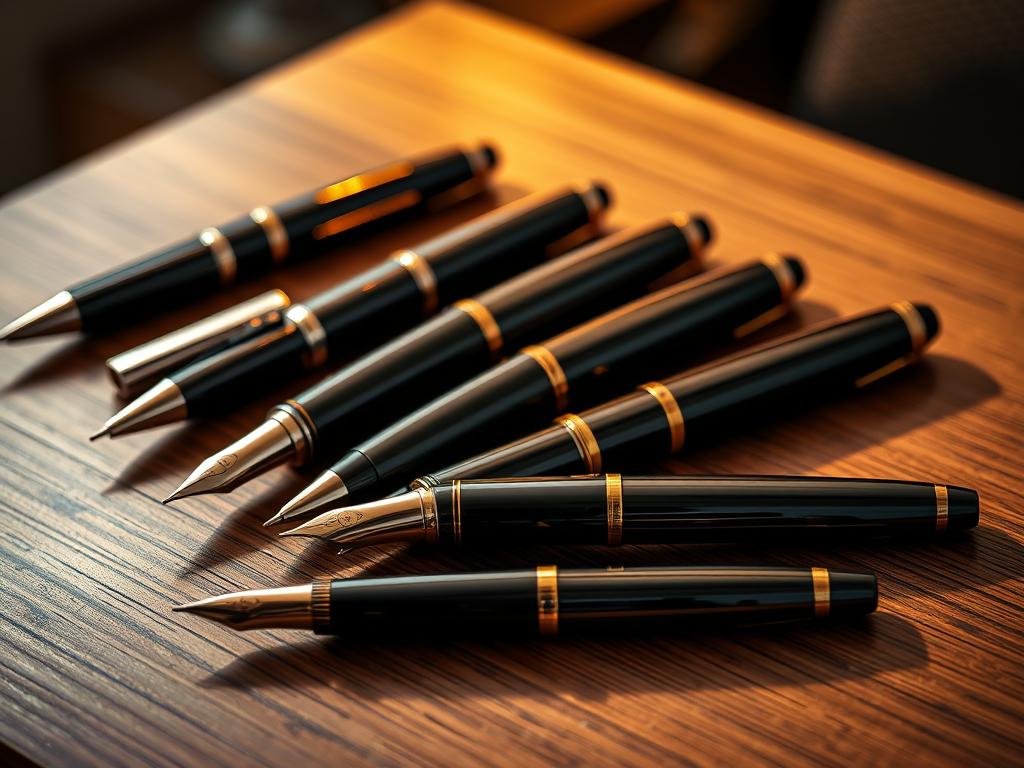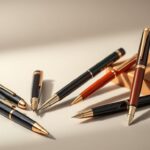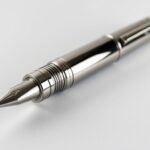For enthusiasts of fine writing instruments, acquiring a fountain pen from international markets offers access to exclusive designs and craftsmanship. Brands like Montblanc, Caran d’Ache, and Namiki create pieces that blend artistry with engineering, appealing to both collectors and casual users. Whether seeking a limited-edition nib or a timeless design, understanding cross-border logistics ensures a seamless experience.
Purchasing these items internationally often introduces unique advantages. Limited releases, regional exclusives, and competitive pricing make overseas markets attractive. However, customs regulations and import fees can impact the final cost. Researching these details beforehand helps avoid surprises while ensuring compliance with local laws.
The elegance of a fountain pen lies in its details—like nib size customization and ink flow precision. Luxury brands emphasize these features, transforming everyday writing into a refined ritual. This guide will explore how to balance practicality with passion when adding such pieces to your collection.
Key Takeaways
- International purchases unlock rare designs from top brands like Montblanc and Namiki.
- Customs fees and import regulations vary by country—always verify before ordering.
- Luxury fountain pens combine functional precision with artistic craftsmanship.
- Nib size and ink compatibility are critical factors for personalized writing experiences.
- This guide covers regulations, maintenance, and authenticity verification for U.S. buyers.
Understanding Duty and Import Regulations for Pens
When acquiring exclusive fountain pens globally, knowing import laws is essential. Luxury writing instruments often face customs scrutiny due to their high value and intricate designs. For example, a Montblanc model with a gold nib may incur different fees than a resin-bodied alternative. These rules protect markets and ensure proper taxation.
Customs Requirements Overview
The U.S. imposes a 3.9% duty on most writing tools, but luxury items often exceed this rate. Declaring the item’s full value is mandatory, and incomplete paperwork can delay shipments. Pens made with precious metals or gemstones may require additional certifications. Retailers like Caran d’Ache simplify this by including invoices detailing materials.
Country-Specific Regulations
Import rules vary widely. Japan’s “de minimis” threshold exempts items under $150, while the EU charges VAT on all purchases. For instance, importing a Namiki maki-e pen into Germany adds 19% tax. Researching these details ensures compliance and avoids unexpected costs. Always verify if the retailer handles duties upfront.
Understanding these guidelines transforms international acquisitions into seamless experiences. Whether it’s a Pelikan’s piston mechanism or a Pilot’s ink flow system, every design choice impacts logistics. Stay informed to enjoy craftsmanship without complications.
Exploring Luxury Pen Brands and Their Appeal
Luxury fountain pens transcend mere writing tools, blending artistry with precision engineering. These instruments appeal to collectors and enthusiasts through meticulous craftsmanship and heritage-driven designs. From Swiss-engineered nibs to Japanese lacquer techniques, each brand tells a story of innovation and tradition.
Iconic Craftsmanship: Caran d’Ache, Montblanc, and Namiki
Caran d’Ache exemplifies Swiss excellence with rhodium-plated nibs and ergonomic designs. Their 2023 Limited Edition model features a diamond-dusted barrel, priced around $2,500. Montblanc merges German engineering with literary homage—the Meisterstück Solitaire Blue Hour incorporates a sapphire-encrusted clip, ideal for smooth ink flow.
Namiki’s Japanese maki-e pens showcase hand-painted urushi lacquer, a technique dating to the 17th century. Collectors praise their Emperor series for balanced weight distribution and 18k gold nibs. These brands prioritize nib customization, allowing users to tailor line thickness for personalized writing experiences.
Diverse Collections for Every Style
Nakaya’s handcrafted urushi pens offer minimalist elegance, while Pilot’s Custom series delivers modern reliability with CON-70 ink converters. Graf von Faber-Castell uses sustainably sourced ebony wood, and S.T. Dupont’s ligne D models feature Guilloché engraving for tactile appeal.
| Brand | Heritage | Price Range | Signature Feature |
|---|---|---|---|
| Montblanc | Germany (1906) | $500-$35,000 | Precious resin bodies |
| Namiki | Japan (1925) | $800-$10,000 | Maki-e lacquer art |
| Graf von Faber-Castell | Germany (1993) | $300-$4,200 | Wood-metal fusion |
Whether drawn to vintage aesthetics or cutting-edge mechanisms, these brands balance classic design with advanced ink delivery systems. Explore varied collections to find instruments that elevate everyday writing into an art form.
A Closer Look at Fountain Pen Features and History
The allure of fountain pens lies in their intricate design and centuries-old evolution. Each component serves a purpose, blending practicality with craftsmanship. Let’s explore how these elements work together and trace their journey through time.
Essential Parts and Their Benefits
A fountain pen’s nib dictates writing style. Gold or steel options offer flexibility, while iridium-tipped points ensure smooth strokes. The feed beneath regulates ink flow, preventing leaks. A converter lets users switch between cartridges and bottled inks, adding versatility.
Modern converters simplify refilling—twist mechanisms draw ink efficiently. Paired with high-quality nibs, they create consistent lines. This setup reduces hand fatigue, enhancing the writing experience during long sessions.
A Brief History of the Fountain Pen
Early models in the 1800s leaked frequently. Lewis Waterman’s 1884 patent introduced capillary feeds, revolutionizing reliability. By the 1950s, brands like Parker used durable resins and cartridge systems.
Today’s designs prioritize precision. Pelikan’s piston-fill mechanism and Lamy’s ergonomic grips show how innovation meets user needs. These advances ensure fountain pens remain cherished tools for self-expression.
| Era | Key Development | Impact |
|---|---|---|
| 1800s | First mass-produced models | Made portable writing accessible |
| 1884 | Waterman’s capillary feed | Reduced leaks, improved function |
| 1950s | Cartridge systems | Simplified ink replacement |
| 2000s | Ergonomic designs | Enhanced comfort for daily use |
From quill replacements to luxury items, fountain pens adapt while preserving their essence. Their legacy endures through thoughtful engineering and artistic detail.
Expert Buying Pens Abroad Tips
Securing a premium writing instrument from overseas requires careful planning. Start by researching brands with proven track records in craftsmanship and customer service. Established names like Montblanc and Pilot often maintain consistent quality across global markets, reducing the risk of defects.
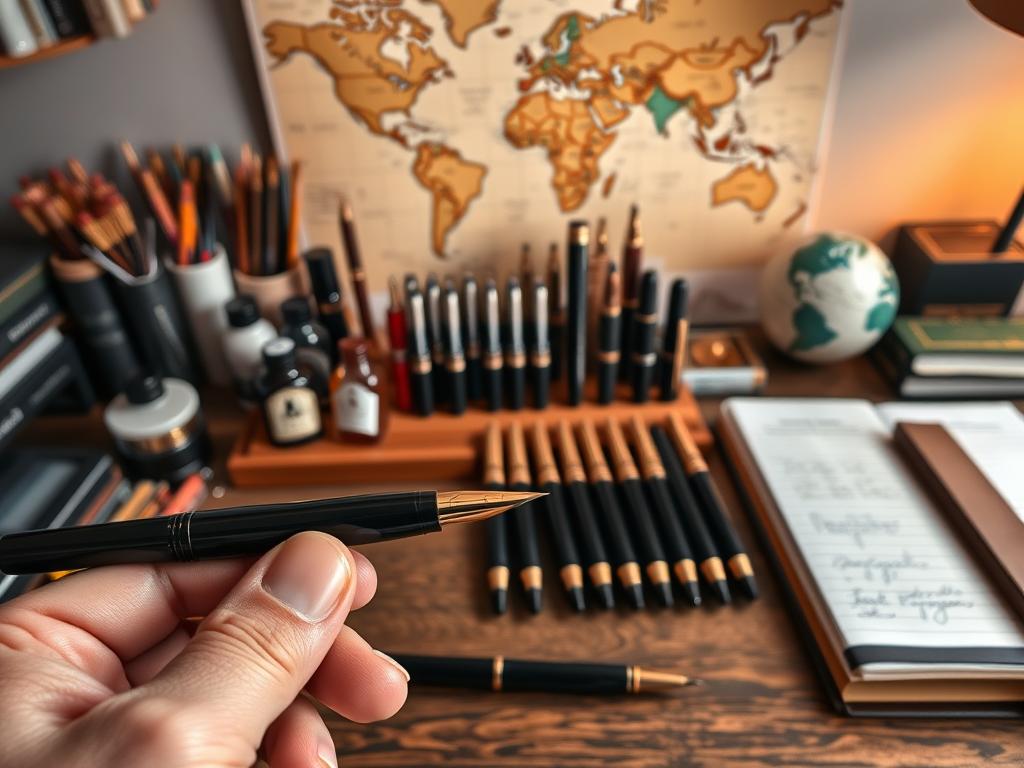
Evaluating Brand Reputation and Quality
Examine nib performance by watching video reviews showing ink flow consistency. A smooth cartridge connection prevents leaks—test this feature if purchasing in person. Reputable Japanese brands like Nakaya use proprietary sizing for components, so verify compatibility with standard accessories.
Paper quality significantly affects writing results. Request samples to test feathering with different inks. For limited editions, demand certificates of authenticity showing production time and materials. Trusted retailers provide high-resolution images of engravings and nib size markings.
Understanding International Pricing Strategies
Compare prices across regions using currency conversion tools. European retailers might offer Pelikan models 15% cheaper than U.S. stores, but factor in 7-10% import fees. Some brands adjust size options by market—Japanese pens often have finer nibs at lower price points.
- Check if warranties transfer internationally
- Calculate total costs including shipping time
- Review return policies for defective items
For detailed steps on avoiding common mistakes, consult verified guidelines covering authentication and seller vetting. Allocate time to read forum discussions about regional pricing trends before committing.
Navigating Duty Fees and Additional Import Charges
Financial planning becomes crucial when importing high-value writing instruments. Import taxes and handling fees can add 10-30% to the total cost, depending on materials and origin. Proactive strategies help collectors maintain budgets while securing rare pieces.
Calculating Customs Duties
Start by identifying your country’s duty rate for stationery. The U.S. applies 3.9% on most pens, but luxury items face higher rates. For example:
| Pen Material | Declared Value | Duty Rate |
|---|---|---|
| Resin | $800 | 4.5% |
| Gold/Silver | $2,500 | 6.7% |
| Gemstone Accents | $5,000 | 8.2% |
Multiply the declared value by the duty rate, then add brokerage fees ($25-$50). Oversized pens or limited-edition sizes may incur extra charges due to special packaging requirements.
Avoiding Unexpected Fees
Always request a detailed invoice from sellers. Customs officials assess fees based on descriptions like “18k gold nib” or “hand-painted lacquer.” For collectibles acquired over years, track purchase dates and values to simplify declarations.
- Use shipping services with prepaid duties
- Verify if retailers underdeclare values (risky and illegal)
- Check CBP.gov for quarterly rate updates
One collector saved $217 by splitting two Nakaya orders to stay under the $800 duty-free threshold. Such choices highlight why research matters. Bookmark this guide and revisit it every few years as regulations evolve.
Comparing Pen Prices and Value When Buying Abroad
How do premium writing instruments justify their price tags? The answer lies in material choices, engineering precision, and the range of features tailored to different users. From German-engineered nibs to Swiss polishing techniques, every detail contributes to long-term performance.
Price vs. Quality: Pelikan, Parker, Waterman, and Lamy
Pelikan’s Souverän series ($300-$1,200) uses hand-finished 18k gold nibs and piston converters for seamless ink flow. Parker’s Sonnet line ($150-$400) offers rhodium-plated steel nibs, appealing to those balancing cost and reliability. Waterman’s Expert models ($200-$600) feature hand-assembled feeds that reduce skipping, while Lamy’s 2000 ($200) boasts a brushed stainless steel body designed for daily use.
| Brand | Price Range | Key Features |
|---|---|---|
| Pelikan | $300-$1,200 | Piston converters, gold nibs |
| Parker | $150-$400 | Rhodium plating, cartridge compatibility |
| Waterman | $200-$600 | Hand-polished feeds, lacquer finishes |
| Lamy | $80-$200 | Ergonomic grips, modular designs |
Investing in a reliable converter system saves money over time by enabling bottled ink use. Users often note Pelikan’s mechanisms outlast competitors by years, while Lamy’s snap-in cartridges suit travelers. As one collector shared: “A $500 pen with perfect ink flow feels worth every penny after a decade of use.”
To assess value, compare nib materials and warranty terms. Mid-range options like Parker’s steel nibs perform well for casual writing, but gold nibs in luxury models adapt to your hand pressure over time. Prioritize brands offering repair services internationally—this ensures your investment remains functional for generations.
Tips for Maintaining and Caring for Your Fountain Pen
Proper care transforms a fountain pen from a simple tool to a lifelong companion. Regular upkeep preserves its performance and aesthetic appeal, ensuring smooth writing for years. Let’s explore practical strategies to keep your instrument in prime condition.
Cleaning and Routine Maintenance
Flush the pen every 4-6 weeks to prevent dried ink clogs. Use lukewarm water with a drop of dish soap for standard cleaning. For stubborn residue, a bulb syringe provides targeted pressure to clear feed channels.
Disassemble the nib and feed carefully. Dry each bit with a microfiber cloth before reassembly. Store the pen upright in its case when unused for extended periods—this maintains ink flow consistency.
| Tool | Purpose | Frequency |
|---|---|---|
| Ultrasonic cleaner | Deep clean nibs | Every 6 months |
| Brass shim | Align tine spacing | As needed |
| Silicone grease | Lubricate piston seals | Annual servicing |
Troubleshooting Common Ink Flow Issues
If lines skip, check the nib’s shape under a magnifier. Gentle pressure on the shoulders can realign misformed tips. For converters not drawing ink, twist the mechanism slowly to create proper suction.
A bit of adjustment often solves flow problems. Rotate the pen slightly while writing—this helps distribute ink evenly across the nib. Persistent issues may require professional tuning to restore optimal performance.
When using fountain pens daily, avoid exposing them to extreme temperatures. Ink viscosity changes in heat or cold, affecting flow rates. With consistent care, these instruments become reliable partners for every writing task.
Choosing the Right Fountain Pen for Your Personal Style
A fountain pen becomes an extension of personal style, merging function with self-expression. Whether sketching ideas or signing documents, its design and mechanics should reflect individual preferences. Let’s explore how to match features to your unique needs.
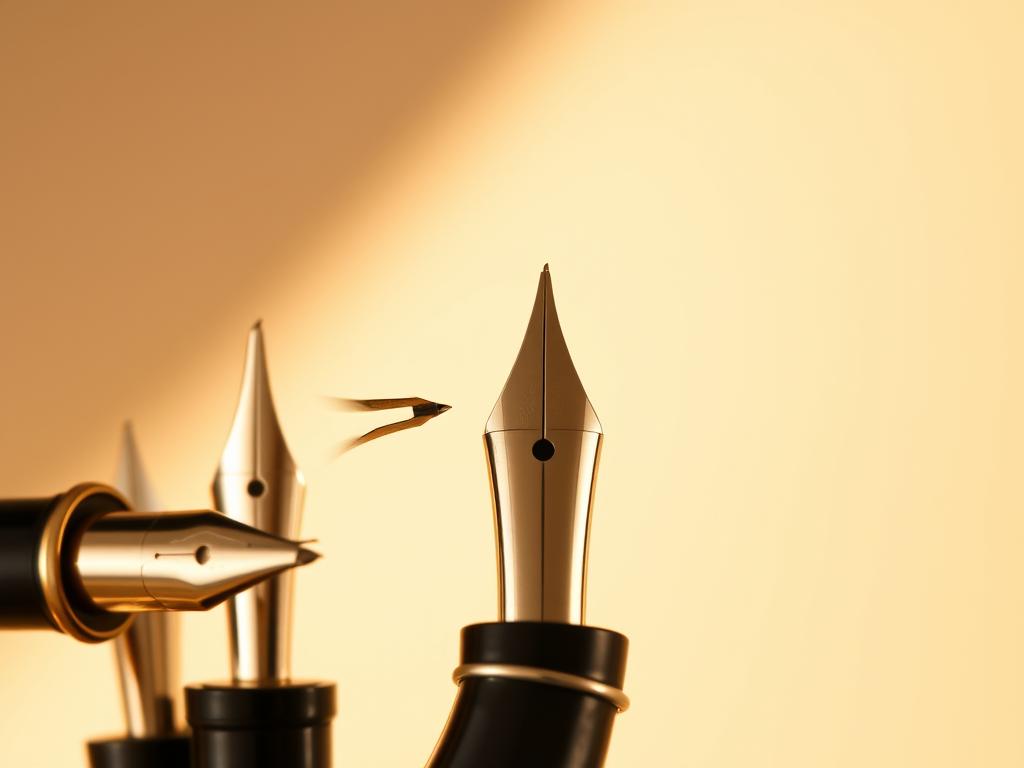
Selecting the Ideal Nib Size and Filling Mechanism
Nib width directly shapes your writing experience. Extra-fine nibs (0.4mm) suit precise scripts, while broad nibs (1.1mm) add dramatic flair. Test different sizes on your favorite paper to find what feels natural.
Ink cartridges offer convenience for travelers, but converters allow custom ink blending. Aurora’s piston-fill system holds 30% more ink than standard options—ideal for long writing sessions. Consider how often you refill versus portability needs.
Notable Options: Cross, Tibaldi, Montegrappa, and Aurora
Cross’s Townsend model combines lacquer finishes with balanced weight for all-day comfort. Tibaldi’s Bononia uses transparent resin to showcase its ink flow mechanics, merging artistry with function.
Montegrappa’s Fortuna Mosaico features mosaic patterns inspired by Venetian architecture. Aurora’s 88 model offers interchangeable nibs, letting users switch between calligraphy and note-taking. These brands prove style and performance coexist.
| Brand | Best For | Signature Feature |
|---|---|---|
| Cross | Professional settings | Rhodium-plated accents |
| Tibaldi | Artistic expression | Hand-engraved caps |
| Montegrappa | Collectors | Limited-edition designs |
Try multiple fountain pens often before deciding. Many retailers offer testers to experience nib feedback firsthand. The right choice elevates every word into a deliberate stroke, transforming routine tasks into moments of pleasure.
Ensuring Authenticity and Reliable Global Shipping
Navigating international purchases of luxury writing tools demands attention to authenticity and logistics. Counterfeit products flood online markets, making verification critical. Authentic retailers prioritize secure packaging, detailed documentation, and responsive customer support to protect your investment.
Spotting Trusted Sellers
Start by cross-referencing brand websites for authorized dealers. Montblanc and Pilot list approved partners, reducing risks. Look for:
- Customer reviews mentioning nib sizes accuracy
- High-resolution photos showing engravings
- Certificates matching serial numbers
One collector shared: “A genuine nib feels like silk on paper—counterfeits can’t replicate that.” Reputable sellers also provide bottled ink compatibility details to prevent leaks.
Smart Payment and Shipping Practices
Always use secure methods like PayPal or credit cards. These offer fraud protection if items arrive damaged. Take time to confirm:
- Insured shipping for fragile pens
- Return windows (30+ days ideal)
- Tracking updates every 48 hours
Proper packaging matters. Ask sellers to wrap pens in foam sleeves and use rigid boxes. For using fountain pens daily, verify nib alignment upon delivery. Minor adjustments ensure smooth writing from day one.
Understanding the Craftsmanship and Materials Behind Pens
The true value of a luxury fountain pen reveals itself through meticulous craftsmanship and material excellence. Unlike mass-produced alternatives, premium instruments blend aesthetics with engineering precision. Every curve and component serves a purpose, creating tools that delight both the eye and hand.
Material Quality and Design Features
High-end brands use materials that balance durability with elegance. Montblanc’s precious resin resists scratches while maintaining lightweight comfort. Visconti’s celluloid barrels showcase swirling colors that evolve with use—a testament to artisanal skill.
Metals like sterling silver and titanium add heft without compromising balance. For example, Graf von Faber-Castell’s Guilloche models feature hand-engraved platinum accents. These choices ensure decades of reliable pen writing performance.
“A well-crafted nib feels like an extension of your thoughts,” notes a collector of Namiki maki-e pens.
Modern cartridge converters enhance functionality. Pilot’s CON-70 mechanism holds 1.0ml of ink—ideal for long writing sessions. Compared to disposable cartridges, these systems reduce waste and allow custom ink blends.
- Resin: Scratch-resistant and lightweight
- Celluloid: Unique patterns that age gracefully
- Precious metals: Enhance durability and tactile appeal
When selecting a new pen, make sure the cap seals tightly to prevent drying. Sailor’s proprietary nib alloys adapt to your writing pressure over time, proving how material innovation elevates daily use. Attention to these details transforms ordinary tasks into moments of refined creativity.
Legal and Compliance Considerations for International Buyers
Navigating international purchases requires more than just an eye for design—it demands legal awareness. U.S. import laws protect consumers and ensure fair trade, but they also add layers of complexity. Luxury writing instruments often involve materials like gold nibs or lacquer finishes, which trigger specific customs requirements. Staying compliant avoids costly delays and preserves your collection’s value.
Regulatory Guidelines for US Importers
The U.S. Customs and Border Protection (CBP) classifies fountain pens under HTS code 9608.30.00, with duties ranging from 3.9% to 8.2%. Items exceeding $800 in value face additional taxes, and materials like precious metals require detailed invoices. For example, a Pelikan M1000 with an 18k gold nib must include certification of its metal content.
Authorized retailers like Montblanc help make compliance easier by providing:
- Duty-paid shipping options
- Material disclosure forms
- Serialized authenticity cards
Proper pen maintenance starts with documentation. Keep purchase receipts and customs forms to prove ownership during repairs or resales. This practice also simplifies insurance claims if damage occurs during transit.
Staying Informed on Changing Legislation
Import laws evolve annually. In 2023, the CBP revised rules for ink cartridge shipments containing liquid above 3oz. Subscribing to agency newsletters or using tools like CustomsInfo Database ensures you’re alerted to changes affecting stationery imports.
Top brands offer compliance updates through customer portals. Pilot’s global store, for instance, flags restricted items before checkout. For complex cases, consult a licensed customs broker—they can clarify gray areas like vintage pen restoration or limited-edition resales.
Regularly reviewing these guidelines help make international collecting both rewarding and risk-free. Pair this diligence with meticulous pen maintenance routines, and your acquisitions will remain functional heirlooms for decades.
Conclusion
Selecting and acquiring a finely crafted writing instrument involves more than aesthetics—it’s a journey through regulations, mechanics, and personal preference. This guide has outlined critical steps, from navigating import duties to evaluating filling mechanisms and verifying authenticity. Luxury brands like Montblanc and Pelikan blend artistry with engineering, but their value depends on informed decisions at every stage.
Respecting customs guidelines ensures smooth transactions, while understanding nib customization or ink compatibility enhances daily use. Pens require meticulous care to maintain their legacy, whether it’s cleaning a piston converter or storing them properly. These instruments aren’t just tools; they’re investments in craftsmanship.
Choosing the right filling mechanism—cartridge, converter, or eyedropper—shapes your experience as much as the pen’s design. Prioritize brands that align with your style and practical needs. By applying the insights shared here, enthusiasts can confidently explore global markets while preserving performance and authenticity.
Whether drawn to Japanese urushi lacquer or German-engineered feeds, every detail matters. Let this guide serve as your roadmap to discovering writing instruments that inspire creativity and stand the test of time.
FAQ
Are fountain pens subject to customs duties when purchased abroad?
Depending on the country, luxury pens like Montblanc or Namiki may incur customs fees if their value exceeds specific thresholds. Travelers should check local regulations to avoid surprises.
How do nib sizes affect the writing experience?
Nib sizes, from extra-fine to broad, influence line width and ink flow. Brands like Pilot and Lamy offer diverse options, allowing users to match their writing style or paper type.
What steps ensure a fountain pen’s longevity?
Regular cleaning with lukewarm water, using quality inks like Graf von Faber-Castell’s, and storing pens horizontally help maintain smooth ink flow and prevent clogs.
How can buyers verify a pen’s authenticity when shopping internationally?
Purchasing from authorized retailers such as Aurora or Cross ensures authenticity. Look for serial numbers, warranty cards, and branded packaging to confirm legitimacy.
Do international prices for brands like Pelikan or Waterman vary significantly?
Yes, factors like regional taxes, exchange rates, and retailer markups can affect pricing. Comparing prices across platforms like Cult Pens or Goulet Pens helps identify deals.
What materials are commonly used in luxury pen craftsmanship?
Premium brands like S.T. Dupont and Tibaldi use materials such as lacquer, precious metals, and celluloid. These enhance durability and aesthetic appeal while reflecting artisanal skill.
Are cartridge converters compatible across brands?
Most brands, including Parker and Caran d’Ache, design proprietary converters. However, international standard cartridges often fit pens labeled as “international short” or “long.”
What should US buyers know about importing pens?
The US imposes duties on items exceeding 0 in value. Luxury pens from Montegrappa or Nakaya may require additional documentation, so reviewing CBP guidelines is advisable.
How do filling mechanisms impact a pen’s usability?
Mechanisms like piston fillers (Pelikan) or vacuum systems (Pilot Custom 823) offer varying ink capacities. Choosing one depends on preferences for convenience, maintenance, and ink variety.
Can ink cartridges be carried on flights without issues?
TSA allows cartridges in carry-ons if sealed. For bottled inks, ensure containers are under 3.4 ounces and placed in a clear plastic bag to comply with liquid restrictions.
